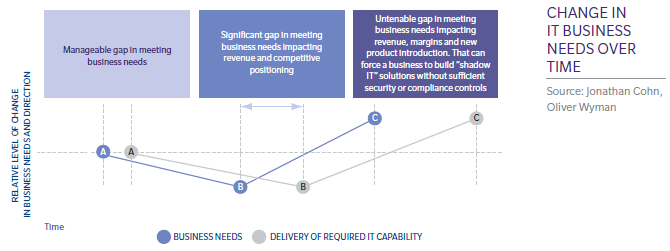The primary reason is a timing mismatch: To be successful, a business has to react quickly to changes in market structure, competition and client needs. In many cases, it must make sizable course corrections from quarter to quarter. Most IT organizations, by contrast, work on an annual cycle. They aren’t equipped to shift course quickly. As a result, despite their best efforts, IT solutions fall further and further behind the business each quarter.
 Consider, for example, the all-too-common problem of IT projects getting rolled out much later than expected. It’s not that IT is lackadaisical about deadlines, or the project manager is subpar. It happens because companies shift plans for their product, market and trading strategies at lightning speed as the environment alters. And every time a company changes direction, the gap between what it needs as an IT solution and what IT has been working to deliver grows disproportionately larger. (See chart, left.)
Consider, for example, the all-too-common problem of IT projects getting rolled out much later than expected. It’s not that IT is lackadaisical about deadlines, or the project manager is subpar. It happens because companies shift plans for their product, market and trading strategies at lightning speed as the environment alters. And every time a company changes direction, the gap between what it needs as an IT solution and what IT has been working to deliver grows disproportionately larger. (See chart, left.)
IT teams find that they’ve been investing time trying to provide solutions to needs that have already changed. Making minor changes to projects becomes more difficult as other altered or unfinished IT initiatives pile up behind them. Worse, some IT endeavors may never get under way, potentially forcing businesses to miss critical opportunities.
This timing problem has two other insidious effects: First, bowing to the pressure to deliver, IT groups will stop adhering to standard solutions and/or architectures, increasing the risk and support costs of a project. Second, business managers become so frustrated that they bring in “shadow IT” solutions that then must be integrated into and supported by the larger corporate IT environment.
Understanding this vicious cycle is the first step toward avoiding it. Boards should be alert to the presence of these issues within the corporations they govern. Asking tough questions of IT and business management ensures they are developing more nimble methods of designing and delivering solutions.


